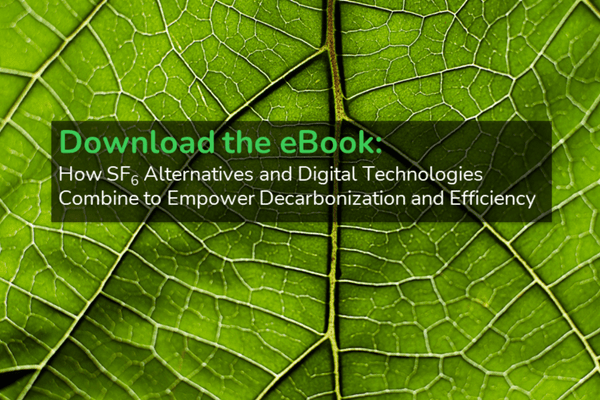The electricity industry is the largest source of greenhouse gas emissions. Here’s why going SF6-free is part of the solution.
Around the globe both countries and companies are racing to decarbonize to reach urgent climate goals. While all industries must take a role in limiting their carbon footprint, the electricity industry must be at the forefront of sustainability improvements. Electricity and heat production are the largest source of greenhouse gas emissions, so positive changes can make a major dent in the world’s carbon footprint.
However, cutting the industry’s carbon footprint is a formidable challenge. Despite current decarbonization efforts, energy-related CO2 emissions have risen to a record-breaking high, with energy generation emissions increasing sharply in 2022. This shows that current efforts aren’t enough to stop climate change. The electricity industry will only meet sustainability targets if they identify and act on all opportunities for improvement — including maximizing DER integration, eliminating SF6 use, and improving efficiency.
For example, think about how increasing distributed energy resources (DERs) use, like wind and solar, could slow climate change. Currently more than 80% of energy worldwide comes from fossil fuels. Moving power generation from fossil fuels to “clean power” like DERs is the most impactful way to reduce global CO2 emissions, according to BNEF. This reduction will not happen unless electricity companies expand DER participation in their existing power networks and better integrate them into the grid.
Why now? MV grid operators are under serious pressure to tackle issues like F-gas use
Fluorinated gases (F-gases) are a family of man-made gases that are used in a number of industrial applications, such as refrigerants, air conditioners, and electrical equipment. They are powerful greenhouses gases (GHG) that contribute to climate change because they have a high global warming potential (GWP) and remain in the atmosphere for thousands of years.
For instance, the greenhouse gas SF6 is commonly contained in electrical equipment, such as medium-voltage switchgear, to power the grid and industrial electrical installations. However, it’s the most potent GHG with GWP 24,300 times greater than that of CO2.
This is why SF6 and other F-gases are being regulated in the EU’s F-gas legislation. The updated regulation on fluorinated greenhouse gases includes the gradual phase out of SF6 in electrical equipment. This is part of a larger F-gas reduction plan that aims to cut the EU’s f-gas emissions by two-thirds, compared to 2014 levels.
SF6 was already banned in the EU for most applications, with a few exceptions and especially in the electricity industry. At the time of its adoption there was no viable alternative technology for medium-voltage equipment. Now the regulation can tackle SF6 because new green options exist.
To comply with this new regulation, electricity companies need to immediately take steps to phase out SF6 in their MV electrical equipment. This is a fundamental step for reaching net zero and producing greener electricity.

Here are 3 areas grid operators must concentrate on to lower their carbon footprint
Let’s look at three of the most impactful changes grid operators can make to reduce their environmental impact:
#1 Increasing renewable energy integration leads to a greener grid
To reach decarbonization targets, electric utilities need to drastically increase their use of distributed energy resources (DERs). It’s not enough to just add more renewables, those DERs must also be better integrated into the existing power network. That’s currently a major challenge for grid operators as they struggle with the variable nature of renewables.
#2 Eliminating SF6 in MV switchgear makes a big impact on decarbonizing power grids
Eliminating SF6 from MV electrical equipment must be a priority because of its GWP. This change is especially important because demand for MV switchgear will continue to grow to meet global infrastructure and electrification needs. By replacing a traditional MV switchgear with SF6-free technology, power grid operators will still have all the same benefits without the heavy environmental cost.
#3 Improving grid efficiencies could eliminate 500 million metric tons of CO2 globally
There’s a lot of waste in electricity systems. Improving grid efficiencies, such as reducing technical losses, can save an estimated 500 metric tons of carbon dioxide per year globally. A more energy efficient network avoids wasted resources, decreases fossil fuel use, and requires lower energy use, which can reduce air pollution.
Electricity 4.0, including digital, SF6-free MV is the backbone of improvements
A more electric and digital world, which we call Electricity 4.0, is key to addressing the climate and energy crises, enabling a sustainable and resilient future. In that future, it is essential that grid operators lower their carbon footprint. Let’s look at how they can use connected, digital technology to decarbonize power grids.
Digital tools improve DER integration. Maximizing renewable use depends on digital tools that increase power grid flexibility. They adjust the balance between supply and demand so that grid operators can modify energy production and consumption.
Digital tools and SF6-free MV technology meet new regulations to support a greener grid. The electricity industry must phase out SF6 in MV electrical equipment. SF6-free MV switchgear, like RM AirSeT RMU, which uses pure air and vacuum technology for insulating and breaking, rather than the GHG SF6. This solution has the same performance and compact size of traditional SF6 switchgear – but is greener and safer than traditional SF6 switchgear.
Digital tools help power grid operators improve efficiency and reduce losses. Smart, connected tools educe losses by improving energy efficiency. By eliminating energy waste through better network management, grid operators have better control over their networks. The tools also reduce interruption time and detect potential problems based on based on calculated current and forecasted load and generation.
Get started building your decarbonized future.
Discover how adopting digital technologies and SF6-free MV solve some of you’re the biggest grid decarbonization challenges.



